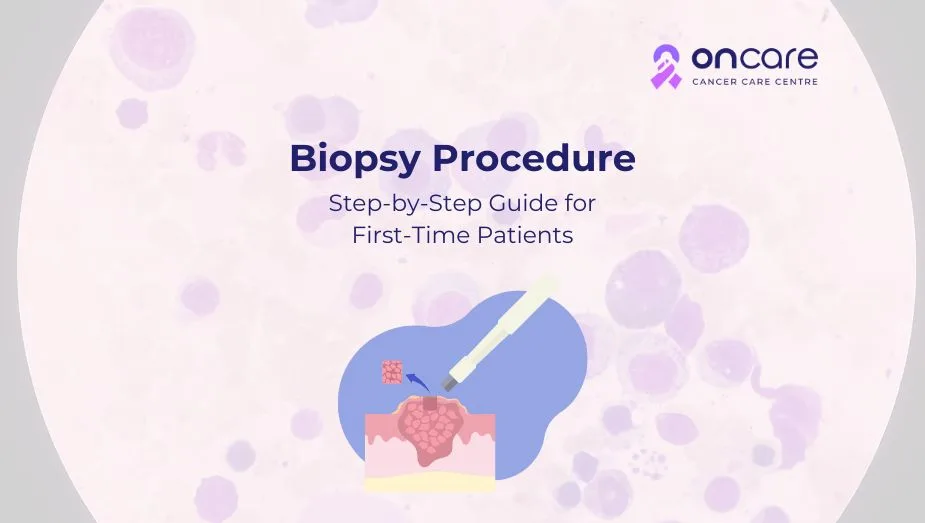Table of Contents
Biopsy Procedure: Step-by-Step Guide for First-Time Patients

Facing a biopsy procedure for the first time can feel triggering and overwhelming to handle. Understanding the process can help you to ease the stress and prepare you for the procedure. A biopsy is a medical procedure used to remove small tissues or cells from the patient's body to determine and diagnose any signs of cancer through a microscope.
In this article, we’ll discover more about the types of biopsy, a step-by-step guide to the biopsy procedure, post-procedure care, and tips for first-time patients.
What is a biopsy?
A biopsy is a medical procedure used to remove a piece of tissue or sample of cells from the patient’s body; it's later tested in the laboratory. A healthcare practitioner might suggest a patient undergo a certain biopsy if they are experiencing any signs of cancer or have identified an area of concern.
A biopsy can determine whether a patient has cancer or any other health issues. For most cancer cases, the only way to make a diagnosis is to perform a biopsy to collect cells for closer examination.
Why is biopsy needed?
A doctor might recommend you undergo a biopsy procedure if any of the imaging tests, including X-rays, CT scans, MRIs, or blood tests, indicate something unusual.
It helps in:
- Confirming a cancer diagnosis
- Identifying the type and stage of cancer
- Guiding the best treatment plan for patients
- It helps to monitor the disease progression
- Diagnosing other health conditions
Types of biopsies
Biopsies are usually performed to identify or determine whether tissue or a tumor is malignant (cancerous) or to determine the cause of an inflammation or unexpected infection.
Here are some of the types of biopsies used to check for any signs of cancer.
including:
- Bone marrow biopsy: Bone marrow aspiration biopsy is a type of biopsy used to evaluate the bone marrow fluid. This test is used to analyze blood disorders such as leukemia, anemia, and infections.
- Endoscopic biopsy: An endoscopic biopsy is a procedure where tissue samples are collected through an endoscope for examination and diagnosis.
- Excisional biopsy: During this type of biopsy procedure, an entire lump or area of skin that appears suspicious is examined. You might receive stitches to close the biopsy site.
- Incisional biopsy: During an incisional biopsy, a doctor might use a scalpel to remove a small area of skin.
- Fine needle aspiration biopsy: A long, thin needle is inserted into the suspicious or cancer-affected area. A syringe is used to collect fluid and cells for analysis.
- Lymph node biopsy: This is a medical procedure where a sample of tissue from a lymph node is taken for examination. It is often used to diagnose the reasons for swollen lymph nodes.
- Needle biopsy : A needle biopsy is a procedure to remove some cells or small tissues from the body using a needle. The sample often removed during a needle biopsy goes to a lab for further testing.
- Punch biopsy: During a punch biopsy, a circular tool is used to collect a small section of the skin’s deep layers.
- Shave biopsy: During the shave biopsy, a healthcare professional uses a tool kinda similar to razor to scrape or collect the surface of the skin.
- Skin biopsy: This procedure is performed to collect small skin tissue samples for examination. It is often performed to diagnose various skin conditions such as rashes or suspected skin cancers.
What’s to expect during a biopsy procedure
Step - 1: Pre-Procedure Consultation
Before the biopsy procedure, your healthcare team might review your medical history. The doctor also explains the reason or cause for the biopsy. If you are taking any kind of medication, inform your doctor prior to the procedure. If you are having any concerns or queries about the procedure, then do not hesitate and ask your doctor.
If you are taking any kind of medications, such as blood thinners, your medical team might ask you to stop for a few days before the procedure.
Preparing for the procedure
Patients often receive instructions based on the type of biopsy procedure the doctor has suggested for their condition, including fasting or avoiding food if anaesthesia is involved.
- The doctor might ask you to wear comfortable clothing.
- Arrange for someone to accompany you to the hospital. (In case you are given any sedative medicine or anesthesia used for the condition)
The biopsy procedure
- Preparation: Depending on the type of biopsy, your healthcare team provides instructions such as avoiding eating or drinking for a certain time before the procedure. In some cases, the medical team gives medicine to sedate or prepare you for the biopsy.
- Local anesthesia: Most types of biopsies are performed under local anesthesia, which helps to numb the area.
- Sample collection: The doctor collects the sample tissues using a needle or surgical instruments.
Post-procedure care
After the procedure your healthcare provider might put a bandage over the area where the biopsy is performed.
You may be advised to apply pressure to the bandage for several minutes to prevent the chance of bleeding.
The doctor will give some post-care instructions, such as watching for a few hours and avoiding any strenuous activities for 24 hours.
Pain is usually minimal and manageable. If you are experiencing extreme pain, then inform your healthcare team to avoid any future complications.
What’s the average time taken for results?
The average time taken for the biopsy results is a few days or weeks. Your medical team might schedule a follow-up appointment to discuss the findings from the tests.
If cancer is detected from these biopsy tests, then the next step is referring to a cancer specialist and deciding on the treatment plan.
Top Tips for first time patients
- If you have any questions and concerns, then ask your healthcare provider and medical team.
- Never hesitate to ask your doctor about your concerns, whether it's about the procedure or its side effects.
- Most biopsies are quick and low-risk. It’s safe and precise in nature, so stay calm and do not panic.
- Ask for help from your family and friends. Accompany them to the hospital. They can provide emotional support and help you with post-procedures.
Consult Today
At Oncare, we understand that undergoing a biopsy procedure for the first time can feel intimidating and stressful. Our team provides quality care with safety and precision. If you have any questions or concerns, we are always here to help.
At Oncare, we offer high-quality cancer treatments, including cancer surgeries, at affordable price ranges with an experienced cancer specialist consultation.
If you or any loved ones of yours are diagnosed with cancer, then visit Oncare Cancer Center and book an appointment with our cancer specialist today. Get an estimated cost of your cancer treatments today!
Frequently Asked Questions
There are several types of skin biopsies are used, include:
- Shave biopsy
- Punch biopsy
- Incisional biopsy
- Excisional biopsy
There are two common types of needle biopsy, include
- Fine-needle aspiration biopsy
- Core needle biopsy
Needle biopsy has some risks including bleeding and infection at the site where the needle is inserted. Some of the other risks including:
- Fever
- Pain at the biopsy site that worsens
- Experiencing changes in the color of skin
- Swelling at the site of biopsy
- Drainage from biopsy site
- Bleeding that doesn’t stop with pressure or a bandage
There are different types of breast biopsies used to identify any changes in the breast.
Including:
- Fine needle aspiration (FNA) biopsy
- Core needle breast biopsy
- Excisional breast biopsy
- Incisional breast biopsy

